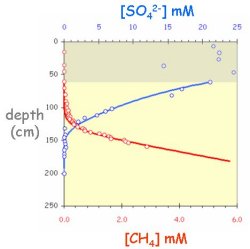 Most of the methane formed in ocean margin and deep-sea sediments is continuously degraded sub-surface by the process of anaerobic methane oxidation. This microbiological conversion is mostly confined to the lower boundary to which seawater sulfate penetrates into the sediment, and it constitutes a, generally very effective, barrier against methane escape from deep sediment strata1. Anaerobic oxidation of methane is probably that deep biosphere process which can at best be traced in the sub-seafloor environment because it takes place at a diffusional interface with enhanced activity. Since the methane-sulfate transition extends below the sea floor as a continuous interface from the coast into the deep sea, it provides a unique environment for biogeochemical studies of the deep biosphere.
Most of the methane formed in ocean margin and deep-sea sediments is continuously degraded sub-surface by the process of anaerobic methane oxidation. This microbiological conversion is mostly confined to the lower boundary to which seawater sulfate penetrates into the sediment, and it constitutes a, generally very effective, barrier against methane escape from deep sediment strata1. Anaerobic oxidation of methane is probably that deep biosphere process which can at best be traced in the sub-seafloor environment because it takes place at a diffusional interface with enhanced activity. Since the methane-sulfate transition extends below the sea floor as a continuous interface from the coast into the deep sea, it provides a unique environment for biogeochemical studies of the deep biosphere. The methane oxidation at the methane-sulfate interface is a key process for global biosphere-geosphere interaction as it integrates the organic carbon flux deeper in the sea floor. As methane is an end-product of organic matter degradation below the sulfate zone, and as the methane accumulation in the sediment constitutes only a small fraction of the entire methane production, the major part of the methane diffuses up to the effective barrier at the lower sulfate boundary. Consequently, the sulfate flux down to this interface is similarly a measure of the entire methane flux from the deep sub-surface2. This sulfate flux can readily be modeled and the process can be experimentally measured, thus providing important information on overall methane fluxes in the sea floor.
In spite of its effectiveness, anaerobic methane oxidation is very sluggish compared to other microbiologically catalyzed sediment processes and may allow the broad coexistence of sulfate and methane at turnover times of months to years3. Only under special conditions, for example by advective pore water flow or through gas ebullition by excessive methane accumulation, do physical transport mechanism effectively enable the methane to escape up through the sulfate barrier4. The constraints on anaerobic methane oxidation and the physical, chemical and biological factors controlling its efficiency are thus gatekeepers for the oceanic methane cycle.
Literature:
1) Reeburgh, W.S., S.C. Whalen and M.JH. Alperin (1993) The role of methylotrophy in the global methane budget. Limnol. Oceanogr. 22: 1-19.
4) Martens, C.S. and J.V. Klump (1980) Biogeochemical cycling in an organic-rich coastal marine basin. I. Methane sediment-water exhacge processes. Geochim. Cosmochim. Acta 44: 471-490.
back to top